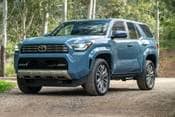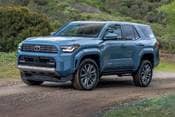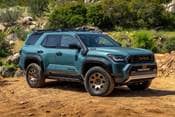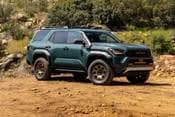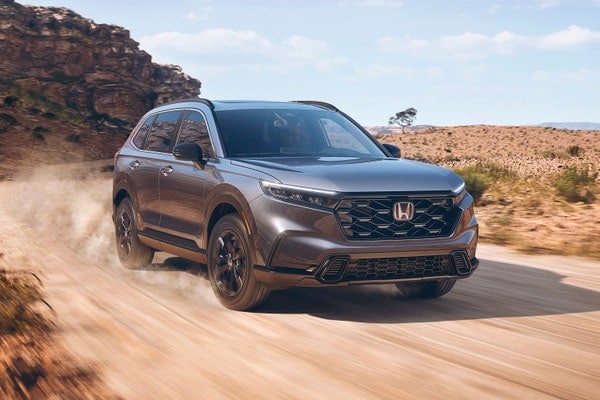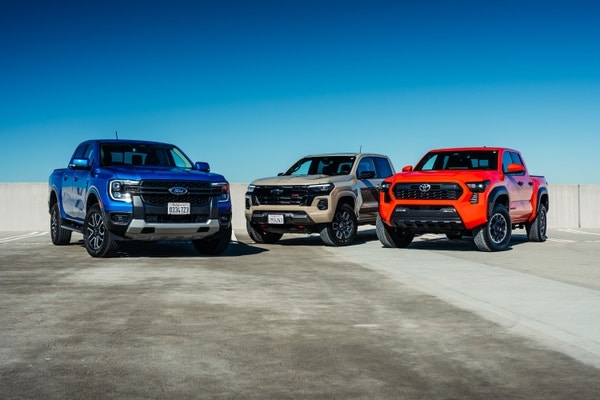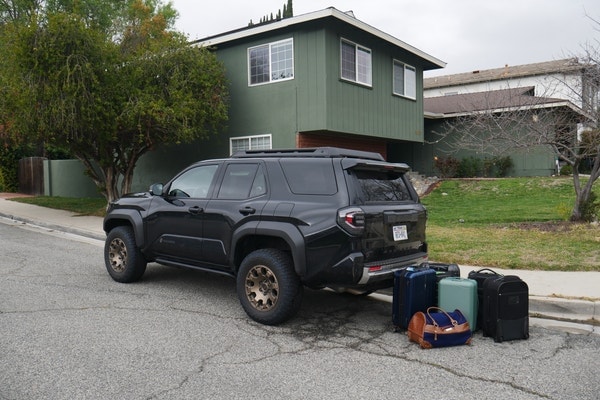The arrival of a redesigned Toyota 4Runner is a rare thing. The model we're all familiar with, the fifth-generation 4Runner, debuted all the way back for the 2009 model year. A solar eclipse has been more frequent in the last two decades than a new 4Runner. But all that changes with the launch of the 2025 4Runner. It has new styling, a revamped interior, different powertrain options, and new versions that further expand this midsize SUV's luxury vibe and off-road capability. As before, the 4Runner should appeal to you if you want something more adventurous than a Toyota RAV4 or Highlander but don't want to fully commit to a Ford Bronco or Jeep Wrangler.
From the rear and in profile, the new 4Runner looks like a faithful reinterpretation of past models. Underneath is hardware that the 4Runner shares with the recently redesigned Tacoma pickup. The 2025 model is appreciably longer and has a slightly longer wheelbase — the measurement between the front and rear wheels — than the previous 4Runner, but overall, this looks and feels like the truck Toyota fans know and love.
What's under the 4Runner's hood?
The big news is that the old SUV's 4.0-liter V6 is gone. It's been replaced a turbocharged 2.4-liter four-cylinder engine. This base version makes 278 horsepower and 317 lb-ft of torque. It's slightly more powerful than the V6 and it should get better mpg as well. An upgraded powertrain is also available for certain 4Runner trims. Called i-Force Max, it pairs the four-cylinder with a hybrid system to increase power to 326 hp and 465 lb-ft.
Both of the 4Runner's powertrains route their power through an eight-speed automatic gearbox. The 4Runner also gets a selectable part- or full-time four-wheel-drive system with a two-speed transfer case. The base 4Runner has 8.1 inches of ground clearance. That's OK but you'll want an off-road-focused model with bigger 33-inch tires to get truly useful clearance for off-roading. The TRD Pro and Trailhunter have 10.1 inches of clearance. Toyota says the new 4Runner will be able to tow up to 6,000 pounds when properly equipped.
New Platinum and Trailhunter trim levels
The 2025 4Runner comes in nine different versions. The SR5, TRD Sport, Limited, TRD Off-Road and TRD Pro trim levels will be familiar to the 4Runner faithful, but there are two big new additions. The 4Runner Platinum takes the Limited model and adds a load of creature comforts such as heated second-row seats, a standard tow tech package, a head-up display, and automatic rain-sensing wipers for a more luxurious on-road experience.
The TRD Pro used to sit alone at the top of the food chain, but it now shares that spot with the new 4Runner Trailhunter. The TRD Pro is built for going fast over off-road whoops and dunes, while the Trailhunter is here to, well, hunt trails. It features Old Man Emu suspension dampers, an ARB roof rack, a raised engine intake snorkel (for improved water-fording capability), and 33-inch off-road tires as standard.
How does the 4Runner drive?
I've sampled both of the 4Runner's new powertrains. The extra torque from the hybrid is noticeable, particularly at low speeds. However, both powertrains have to work pretty hard to keep pace at highway speeds. From a fuel economy standpoint, the hybrid only nets you a few extra mpg at best, depending on trim level. But to give these four-cylinders some kudos, a last-generation 4Runner got an estimated 17 mpg combined, while Toyota says the new model can do at least 21 mpg combined.
There are many different versions of the new 4Runner, so the driving experience depends not just on what’s under the hood but also on how aggressive the tires are, how beefed-up the suspension is, and so forth. An entry-level gas-only SR5 model with street tires drives drastically different than the ultra-rugged Trailhunter, which has the hybrid powertrain and fat 33-inch tires.
Customers should know what they’re getting into before they go to buy. If you plan on doing some heavy-duty off-roading, the TRD Pro or Trailhunter could both be right for you. Expect them to drive like trucks, with lots of lean during cornering and some pretty over-the-top artificial engine noises that Toyota pipes into the cabin to make everything feel more intense.
If your 4Runner will spend most of its life on pavement, the SR5, Limited or Platinum are the best choices. They have the most comfortable ride quality and stable handling. For me, the sweet spot is the TRD Off-Road. It has enough stuff to tackle some dirt but still feels livable in the real world. It also gives you the choice of both engines.
Our team will put the 4Runner to the test off-road much more in the coming weeks, but I got to sample a few trim levels in the dirt. As I noticed on the road, the hybrid does provide a lovely extra cushion of torque to help conquer steep inclines. It must be said, though, that every 4Runner that I drove in 4-Low had no issue overcoming what stood before it. I locked the rear differential just for fun at one point, but even that wasn't necessary. My favorite feature during the whole experience was the multi-view off-camera angles. Using them to spot obstacles felt like a cheat code for sightlines when I needed them most.
How's the 4Runner's interior?
Toyota has carried over its newest truck cabin design into the 4Runner like it's a copy-and-paste job. The chunky shifter, knobs, buttons and switchgear are new to the 4Runner but will be very familiar to owners of the most recent Tacoma and Tundra. We like the control layout, and there is new tech as well. There's an available 14-inch center touchscreen, multiple USB-C ports to keep you charged up, a wireless charging pad, and wireless connectivity for Apple CarPlay and Android Auto too.
Another quirk of 4Runners in the past was their cramped interior dimensions. Unfortunately, that also carries over to the new generation. The seating position is high (which you'd expect for an SUV of this type), but the front row will feel snug for anyone over 6 feet tall. The doors and center console feel too close to you and headroom will be tight for taller passengers. The same carries over to the rear seats. A third-row seat is available for certain 4Runner trim levels.
All 4Runners also come with a load of safety tech as standard. The Toyota Safety Sense 3.0 system includes lane departure warning, adaptive cruise control, speed sign recognition, lane keeping assistance and more.
How much will the 4Runner cost?
With so many 4Runner trim levels to pick from, this SUV will appeal to a large customer base. The new model starts at just over $42,000, including the destination charge. Prices go up dramatically from there. A Trailhunter or TRD Pro pushes north of $68,000, also including destination. At some point, you have to wonder how much is too much because a Lexus GX costs roughly the same money and, from my experience in both products, is much nicer across the board.
In terms of competitors, the 4Runner stacks up against a wide range of truck-based options. Honda made some real upgrades to its latest Passport, making it a solid alternative to the 4Runner TRD Off-Road. For those of you who seek to hit the dirt a bit harder than that, the Ford Bronco and Jeep Wrangler both offer the capability to match (or best) the Toyota.

